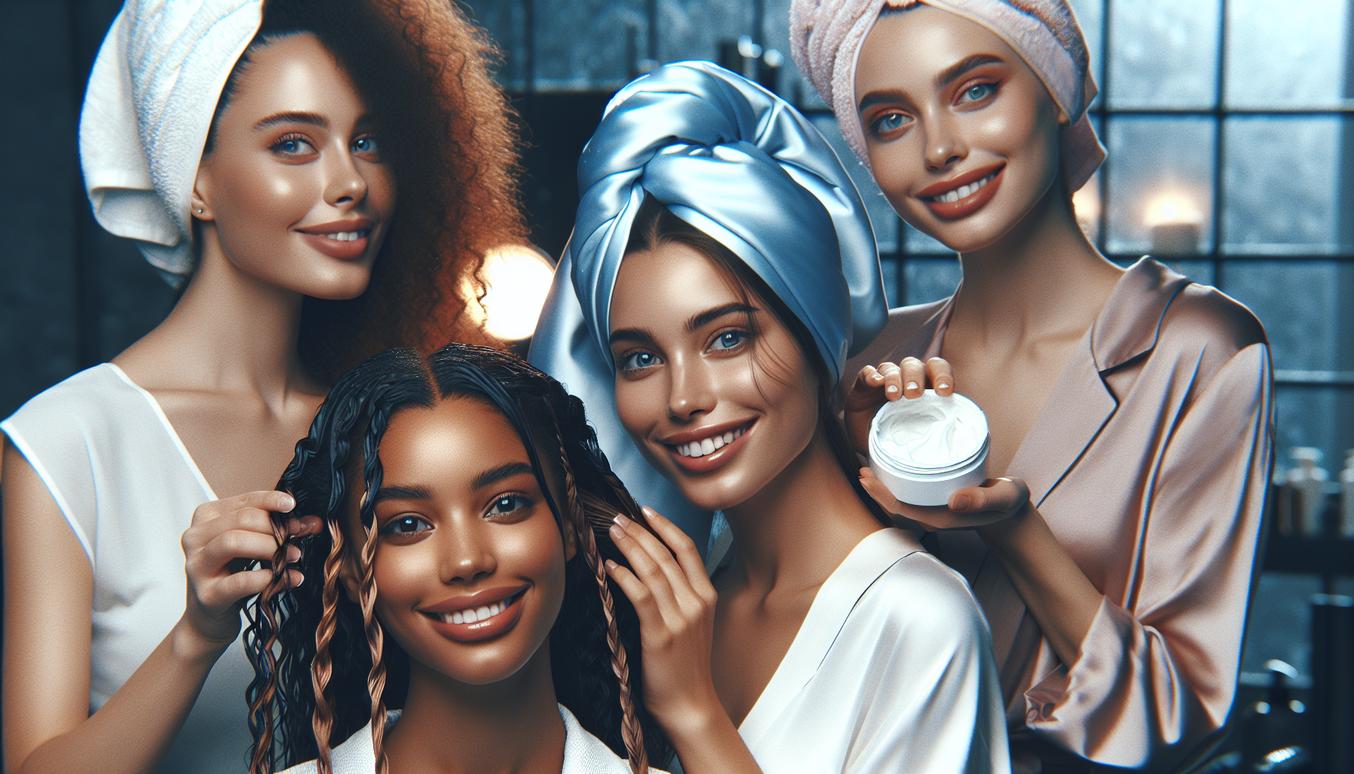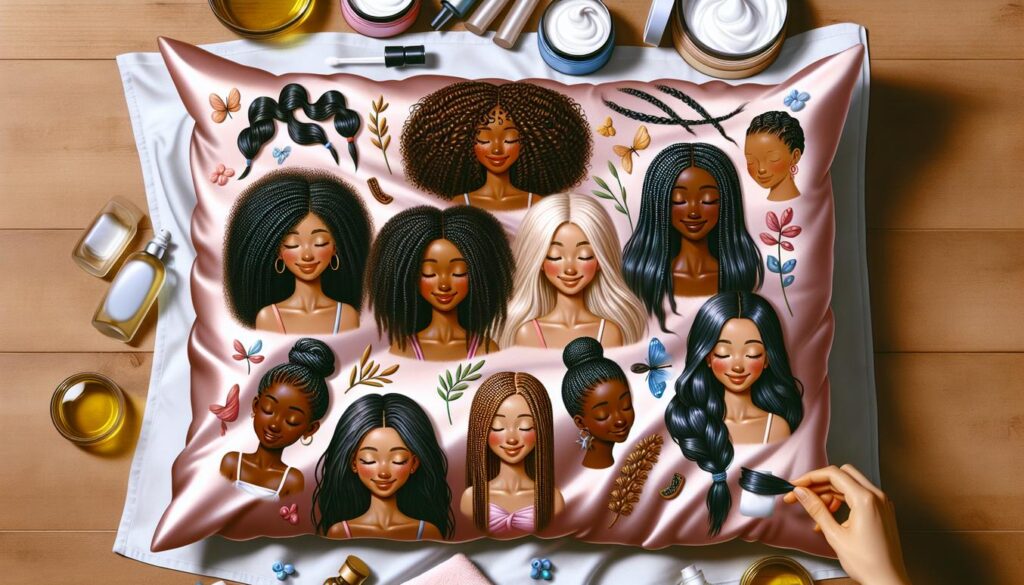The Ultimate Guide to Overnight Hair Care: Wake Up to Healthier Hair in 2025
Table of Contents
- Why night routines matter for hair health
- Quick self-check: identify your hair type and sleeping needs
- Tailored overnight routines by hair type
- Protective styles and low-effort sleep techniques
- Best fabrics and tools for nighttime care
- DIY overnight treatments and gentle masks
- Nutrition and habits that support nightly repair
- Common overnight mistakes and how to avoid them
- Sample 7-night plans for different goals
- Ingredient primer: what to look for and what to skip
- Quick troubleshooting and when to consult a specialist
- Resources and further reading
Imagine waking up, looking in the mirror, and seeing hair that’s smooth, hydrated, and ready for the day with minimal effort. This isn’t a far-off dream; it’s the power of a solid overnight hair care routine. While you rest, your hair can either be fighting a losing battle against friction and moisture loss or undergoing a transformative repair process. This guide is designed for busy adults and beginners who want to unlock the secrets to healthier hair while they sleep. We will explore simple, effective strategies tailored to your specific hair type, turning your eight hours of sleep into a powerful beauty treatment.
Why night routines matter for hair health
You might think hair care is a daytime activity, but the night offers a unique opportunity for restoration. While you sleep, your body is in peak repair mode, increasing blood flow to follicles and promoting growth. However, this is also when your hair is most vulnerable to physical damage. Tossing and turning on a cotton pillowcase creates friction, which lifts the hair’s outer layer, the cuticle. This leads to frizz, tangles, and breakage.
A dedicated overnight hair care plan has two primary goals: protection and treatment. By protecting your hair from mechanical stress, you preserve its integrity and length. Simultaneously, the uninterrupted hours provide the perfect window to apply nourishing treatments that can penetrate the hair shaft deeply without being disturbed by environmental factors like sun or wind. This dual approach ensures you wake up with hair that is not just undamaged, but actively healthier.
Quick self-check: identify your hair type and sleeping needs
Before you can build the perfect routine, you need to understand your hair’s unique characteristics. The most effective overnight hair care is not one-size-fits-all. Take a moment to assess your hair based on a few key metrics.
Assessing porosity, density and texture
Understanding these three pillars will guide your product and technique choices. They determine how your hair absorbs moisture and reacts to different styles.
- Texture (Fine, Medium, Coarse): This refers to the thickness of an individual hair strand. Roll a single strand between your fingers. If you can barely feel it, you have fine hair. If you can feel it easily, it’s medium. If it feels thick and strong, it’s coarse.
- Density (Low, Medium, High): This is about how many hair strands are on your head. Look at your scalp in the mirror. If you can easily see your scalp, you likely have low-density hair. If it’s difficult to see, you have high-density hair.
- Porosity (Low, Normal, High): This is your hair’s ability to absorb and retain moisture. Place a clean, dry strand in a glass of water. If it sinks quickly, you have high porosity (it absorbs water fast but can lose it just as quickly). If it floats for a long time, you have low porosity (the cuticle is tightly packed, making it hard for moisture to get in). If it sinks slowly, you have normal porosity.
Tailored overnight routines by hair type
Once you’ve identified your hair’s properties, you can create a targeted nightly plan. The key is to address your hair’s specific needs without causing new problems, like weighing it down or causing buildup.
Fine or straight hair: minimal-weight strategies
The biggest challenge for fine or straight hair is preventing oiliness at the roots and tangles at the ends. Your overnight hair care should focus on protection with minimal product.
- Technique: Gently brush your hair to detangle it. Secure it in a loose, low braid or a loose bun on top of your head using a soft scrunchie. This prevents tangles from forming as you sleep.
- Product: Less is more. If your ends are dry, apply a single drop of a lightweight oil like argan or grapeseed oil only to the very tips. Avoid applying products near the scalp.
Wavy and loosely curly: preserving pattern and moisture
For wavy and curly hair, the goal is to wake up with defined, frizz-free waves and curls, not a flattened mess. Your routine should focus on preserving your hair’s natural pattern.
- Technique: The “pineapple” is your best friend. Loosely gather your hair at the very top of your head and secure it with a satin or silk scrunchie. This protects the curls from being crushed. For looser waves, a loose braid can also work well.
- Product: A light mist of water mixed with a small amount of leave-in conditioner can refresh waves. You can also apply a small amount of curl cream by scrunching it into the ends to encourage definition.
Curly and coily textures: gentle protection and hydration
Type 3 and 4 hair is prone to dryness and breakage, so your overnight hair care must prioritize deep hydration and gentle protection.
- Technique: The pineapple method also works well here. Alternatively, section your hair into several loose twists or braids (the “multi-pineapple”). This stretches the curls slightly to prevent tangles and shrinkage while protecting them.
- Product: This is the perfect time for the LOC (Liquid, Oil, Cream) or LCO (Liquid, Cream, Oil) method. Apply a water-based leave-in, seal with a nourishing oil, and finish with a cream to lock in moisture overnight.
Protective styles and low-effort sleep techniques
A protective style is any hairstyle that keeps your ends tucked away and minimizes manipulation. For sleep, these styles should always be loose to avoid tension on your scalp and follicles.
- Loose Braid: A simple, classic option for straight, wavy, and longer curly hair. It effectively prevents tangles.
- The Pineapple: Ideal for preserving curl patterns. It keeps the bulk of your hair from being crushed while you sleep.
- Loose Top Knot or Bun: Gathers all hair on top of the head, away from the friction of the pillow. Always use a soft tie like a scrunchie.
- Twists or Bantu Knots: Excellent for coily and very curly hair, these styles protect hair, lock in moisture, and can create a beautiful, defined style for the next day.
Best fabrics and tools for nighttime care
The surfaces your hair touches while you sleep are critically important. Swapping out a few key items can make a world of difference in your overnight hair care success.
- Pillowcases: Standard cotton pillowcases are highly absorbent, drawing moisture out of your hair. Their rougher texture also snags and pulls on hair cuticles. Switch to silk or satin. These fabrics have a smooth surface that allows hair to glide across it, reducing friction and preventing breakage.
- Bonnets and Scarves: For an extra layer of protection, especially for curly and coily types, a satin or silk-lined bonnet or scarf is essential. It encases the hair, protecting it from friction, preserving styles, and helping it retain moisture from overnight treatments.
- Hair Ties: Avoid traditional elastic bands with metal clasps, which can snag and break hair. Opt for satin or silk scrunchies, spiral hair ties, or other snag-free options.
DIY overnight treatments and gentle masks
Your sleep cycle is the ideal time for deep conditioning treatments. In 2025 and beyond, the focus is on lightweight, nourishing formulas that won’t create a mess or weigh hair down.
Nourishing oil blends and how to use them safely
Natural oils can seal the cuticle and replenish lost lipids. However, it’s crucial to use them correctly.
- Lightweight Oils (Fine/Oily Hair): Argan, grapeseed, jojoba oil. Use sparingly and apply only to the ends.
- Heavier Oils (Dry/Coarse/Coily Hair): Coconut, olive, avocado oil. Can be applied more generously from mid-lengths to ends.
- How to Use: Warm a few drops in your palms and smooth over your hair. Focus on the ends. To avoid greasy roots, never apply directly to the scalp unless for a specific scalp treatment. Always cover your hair with a bonnet or wrap to protect your bedding.
Cream masks and leave-in options for overnight wear
Many leave-in conditioners and hair masks are designed for overnight use. They are formulated to absorb fully without leaving a heavy residue. Look for products with ingredients like hyaluronic acid for moisture, or hydrolyzed proteins for strength. Apply a small amount to damp or dry hair, comb through, and protect with a loose style and bonnet.
Nutrition and habits that support nightly repair
True hair health starts from within. Your nightly routine can be supported by daily habits that promote strong, resilient hair growth.
- Balanced Diet: Ensure you are getting enough protein (the building block of hair), iron, zinc, and biotin. These nutrients are essential for follicle health.
- Hydration: Drinking enough water is crucial for overall health, including that of your scalp and hair.
- Stress Management: High stress levels can contribute to hair shedding. Incorporating relaxing evening rituals can benefit both your mind and your hair.
Common overnight mistakes and how to avoid them
Even with the best intentions, some common habits can sabotage your overnight hair care efforts.
- Sleeping with Wet Hair: Hair is at its most fragile when wet. Tossing and turning can stretch and snap wet strands. This can also lead to a condition called hygral fatigue, where the constant swelling and drying of the hair shaft weakens it over time. Aim to have your hair at least 80% dry before bed.
- Using Tight Hairstyles: A tight ponytail or bun can cause tension alopecia, a form of hair loss from consistent pulling. Always keep sleep styles loose and comfortable.
- Over-Oiling the Scalp: While some scalp treatments are beneficial, coating your scalp in heavy oils every night can clog follicles and lead to buildup. Focus oils on the hair shaft itself.
Sample 7-night plans for different goals (strength, moisture, length retention)
Here are sample weekly plans to structure your overnight hair care. Adjust based on your wash day schedule.
| Night | Goal: Moisture Boost (for Dry/Damaged Hair) | Goal: Strength and Repair (for Brittle Hair) | Goal: Length Retention (for All Types) |
|---|---|---|---|
| 1 (Wash Day Eve) | Apply a nourishing oil (coconut/avocado) to lengths and ends. Protect with a bonnet. | Apply a lightweight protein mask or leave-in. Protect with a loose braid. | Apply 2-3 drops of lightweight oil (jojoba/argan) to ends. Sleep in a loose braid. |
| 2 | Refresh with a light mist of water and leave-in. Sleep in a pineapple/loose bun. | Rest night. Sleep in a protective style (pineapple/loose braid). | Rest night. Sleep on a silk pillowcase with hair in a pineapple. |
| 3 | Rest night. Sleep in a protective style on a silk pillowcase. | Rest night. Sleep in a protective style on a silk pillowcase. | Gently massage scalp for 3-5 mins. Sleep in a loose top knot. |
| 4 | Apply a small amount of hair cream to ends. Protect with a scarf. | Apply a bond-building serum to ends. Protect with a loose braid. | Rest night. Sleep in a loose braid on a silk pillowcase. |
| 5 (Wash Day Eve) | Apply a hydrating mask or deep conditioner. Protect with a bonnet. | Apply a nourishing oil (olive/almond) to lengths. Protect with a bonnet. | Apply a few drops of lightweight oil to ends. Sleep in a pineapple. |
| 6 | Rest night. Sleep in a pineapple/loose bun. | Rest night. Sleep in a protective style. | Rest night. Sleep on a silk pillowcase with hair in a loose bun. |
| 7 | Rest night. Sleep in a protective style on a silk pillowcase. | Gently massage scalp. Sleep in a protective style. | Rest night. Sleep in a loose braid. |
Ingredient primer: what to look for and what to skip
Reading labels is key. Knowing which ingredients help and which may harm allows you to make informed choices for your nightly routine.
- Look For:
- Humectants: Glycerin, hyaluronic acid (draw moisture into the hair).
- Emollients: Shea butter, natural oils (soften and smooth the hair).
- Proteins: Keratin, silk protein, hydrolyzed wheat protein (strengthen the hair shaft; use in moderation to avoid protein overload).
- Ceramides: Help repair and fortify the hair cuticle.
- Skip (or Use with Caution):
- Drying Alcohols: Alcohol denat, isopropyl alcohol (can be drying when high on the ingredients list).
- Heavy Silicones: Dimethicone (can build up on some hair types, requiring clarifying shampoos).
- Sulfates: Sodium lauryl sulfate (usually found in shampoos, but ensure your leave-in products are free of harsh detergents).
Quick troubleshooting and when to consult a specialist
Sometimes, despite your best efforts, issues arise. If your hair feels greasy in the morning, you may be using too much product or applying it too close to your roots. Try using less or switching to a lighter formula. If you experience persistent dryness or breakage, your hair may need a better balance of moisture and protein.
However, if you notice significant hair loss, unusual scalp irritation, or sudden changes in your hair’s texture, it is important to seek professional advice. These can be signs of underlying health conditions. The NHS offers reliable guidance on hair loss and care and can help you determine when it’s time to see a doctor or dermatologist.
Resources and further reading
Building an effective overnight hair care routine is a journey of discovery. Continue learning about the science of hair and exploring different techniques to find what works best for you.
- PubMed: A fantastic resource for finding peer-reviewed scientific studies on hair biology, ingredient efficacy, and dermatological conditions related to hair and scalp health.
- Rich Hair UK: An informative blog offering practical tips and insights into various aspects of hair care, from routines to understanding different hair types.
By investing just a few minutes each evening, you can transform the health and appearance of your hair. A consistent and thoughtful overnight hair care routine is one of the most effective ways to achieve your long-term hair goals, proving that sometimes, the best beauty treatments truly happen while you sleep.





